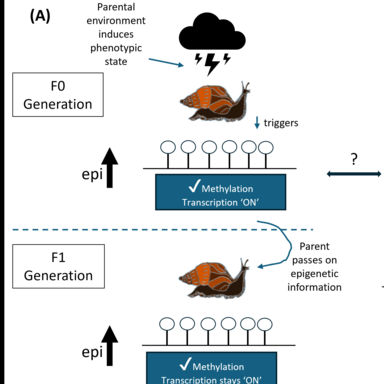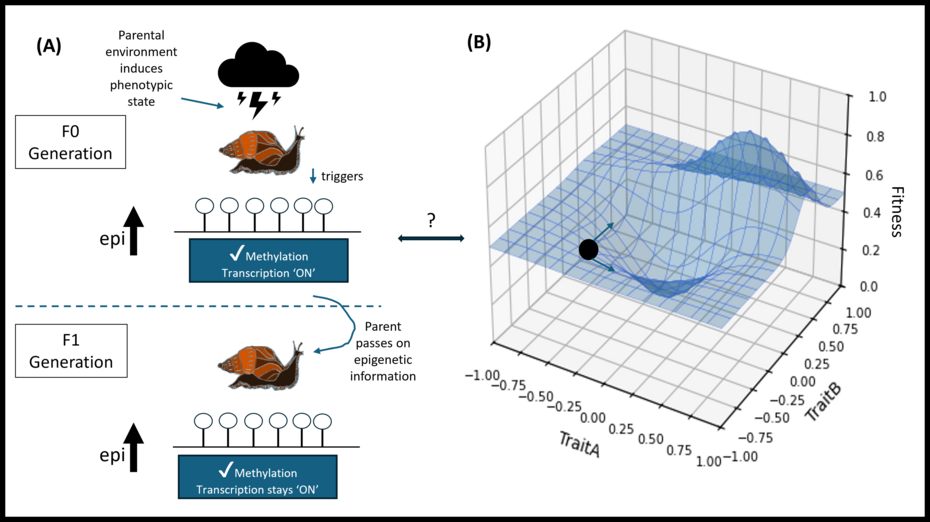Project A.21

- PhD student: Uthara Srinivasan
- Supervisor: Hanna Kokko
- Co-Supervisors: Meret Huber
- Further TAC-members: Tom Keaney , Sinead English
- Research Group
I am working on extending and improving existing models of epigenetic adaptation; the core challenge of my PhD is to develop a unified framework that combines population (epi-)genetic models of transgenerational epigenetic inheritance (TEI) with the Fisher’s geometric model (FGM), a model of adaptation that captures the N-dimensional trait-complexity realistic to most organisms.
Adaptation is no longer seen as driven solely by inherited genetic variation, with growing support for a broader view of heredity that encompasses, though is not confined to, the inheritance of epigenetic information. Recent findings reveal that environmental stresses experienced by parents or grandparents can lead to adaptive changes in offspring, with these effects often lasting across several generations. For example, C. elegans exposed to heat or starvation produce small RNAs that confer stress tolerance to multiple subsequent generations (Rechavi, O et al., 2014 ; Jobson, M. A et al. , 2015). Such a transgenerationally inherited response can be selected for and is highly relevant in the context of rapid environmental change (e.g., climate change) (Figure (A)).
However, the precise role of these non-genetically inherited materials in adaptation remains unresolved. Most existing population (epi-)genetic models of Transgenerational Epigenetic Inheritance (TEI) suggest that having access to both genetic and ‘epi’-mutations positively impacts fitness and adaptation, particularly under rapidly changing environmental conditions (McNamara et al., 2016; Uller et al., 2015). But these results rely on simplistic or overly optimistic model assumptions, which fail to account for constraints imposed by the requirement that a complex organism fit to a complex changing environment.
Using various mathematical approaches, my project will integrate recent models of TEI (Figure (A)) with ‘classical’ adaptation theory, which conceptualises evolution as a step-by-step exploration of complex phenotypic landscape, where each step brings an organism’s phenotype closer to the best possible fit with its environment (Figure (B)). Through this project, I aim to critically assess the role of epigenetic inheritance in adaptation across a general, non-species-specific context, while retaining the flexibility to make system-specific simplifications. More pointedly, I hope to show under which conditions this rapidly accessible alternative source of heritable variation has net neutral, beneficial, or deleterious effects during the course of evolutionary adaptation.
References:
Jobson, M. A., Jordan, J. M., Sandrof, M. A., Hibshman, J. D., Lennox, A. L., & Baugh, L. R. (2015). Transgenerational effects of early life starvation on growth, reproduction, and stress resistance in Caenorhabditis elegans. Genetics, 201(1), 201-212.
McNamara, J. M., Dall, S. R., Hammerstein, P., & Leimar, O. (2016). Detection vs. selection: integration of genetic, epigenetic and environmental cues in fluctuating environments. Ecology Letters, 19(10), 1267-1276.
Rechavi, O., Houri-Ze’evi, L., Anava, S., Goh, W. S. S., Kerk, S. Y., Hannon, G. J., & Hobert, O. (2014). Starvation-induced transgenerational inheritance of small RNAs in C. elegans. Cell, 158(2), 277-287.
Uller, T., English, S., & Pen, I. (2015). When is incomplete epigenetic resetting in germ cells favoured by natural selection? Proceedings of the Royal Society B: Biological Sciences, 282(1811), 20150682.
